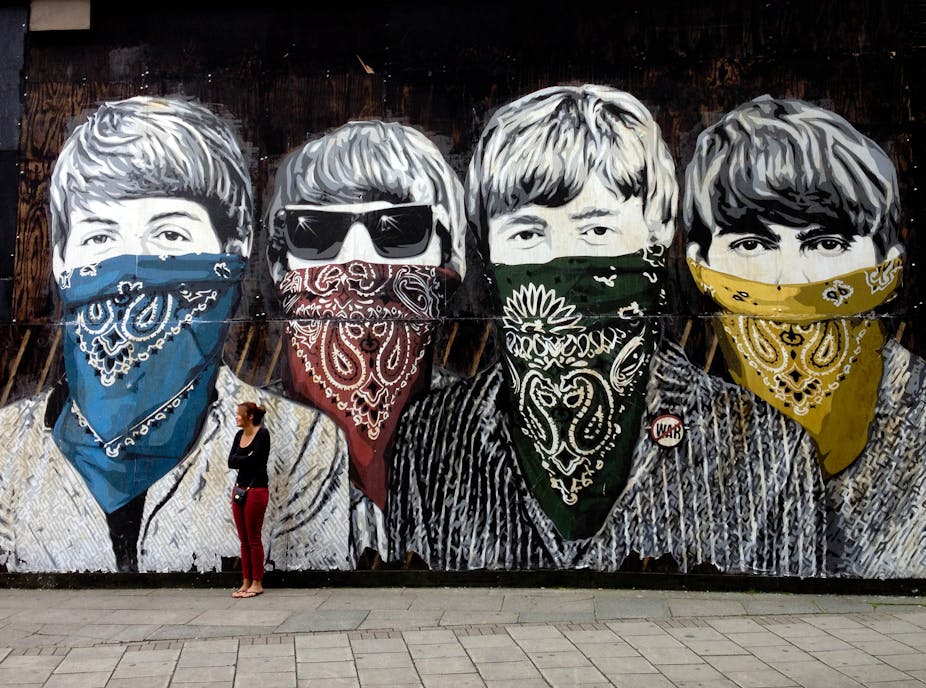Rock ‘n’ roll is turning 60 … about now. The exact date depends on who is doing the reminiscing. But should this event be treated as a birthday celebration or a memorial?
In films such as Torn Curtain (1966) and Frenzy (1972), Alfred Hitchcock was determined to bring murder to the screen in a way that emphasised the sheer physicality of the act – to show how hard it actually is to kill someone.
It can be just as difficult to kill a concept. In music, the most basic genre distinctions – classical, jazz, rock – stagger on in the 21st century, despite the best efforts of many to render them defunct.
Accounts of rock’s demise have been more protracted and painful to observe than one of Hitchcock’s elongated death scenes. Yet rock has been defined in so many different ways that the very idea of a definitive start (or end) point seems suspect.
Most orthodox interpretations of the genre betray a kind of bell curve existence. Here the story begins in the mid-1950s, peaks with The Beatles, then undergoes a long descent through punk and beyond. The decline is so widely accepted that it is hard to deny.
The rock canon

Nothing reinforces the waning of rock music more than the rock canon. Every aesthetic form develops narratives of consecration; no other has seen consecration taken to such repetitive extremes.
For decades, listeners have compiled countless lists of rock’s greatest albums in barely altered – always male, Anglo-American dominated – arrangements.
The Beatles are immovable at the apex of rock ‘n’ roll glory, something many music scholars agree with audiences on. The sheer volume of Beatles-related reference texts is astonishing. They range from affectionate anthologies (The 2010 Cambridge Companion to The Beatles) to sober examinations (Martin King’s 2013 Men, Masculinity and The Beatles) to post-1960s doomsday tracts (Elijah Wald’s 2009 How The Beatles Destroyed Rock and Roll).
Recent debates among nostalgia buffs centre on whether The Beatles’ Revolver (1966) album has overtaken Sgt. Pepper’s Lonely Hearts Club Band (1967), long considered the genre’s foremost artefact. For their 2013 book 100 Best Albums of All Time, Australian authors Toby Creswell and Craig Mathieson claim some kind of subversive coup by rejecting Sgt Pepper’s in favour of its predecessor.
The Beatles dance with Stockhausen
Yet what The Beatles also evoke is rock’s disintegration as a clear-cut style. Reductive takes on their legacy contrast with the innovative nature of their music. The 1967 cover of Sgt Pepper’s gives a major clue here.
Peering out morosely from the back row of that famous celebrity gathering is German composer Karlheinz Stockhausen, whose pioneering Hymnen (Anthems) appeared the same year. A melange of dismembered national anthems for tape, electronics and/or orchestra, Hymnen suggests contradictions and cross-fertilisations; it speaks of sonic borders being torn down.
The following year, The Beatles were channelling Stockhausen with Revolution 9 from their White Album.
At the time, in an interview with the New Musical Express, Paul McCartney expressed admiration for Stockhausen and fellow modern composer Luciano Berio, saying he was “sick of doing sounds that people can claim to have heard before”.
The Beatles were always looking ahead, so it is ironic that their high points are now frozen in time as insurmountable monuments.
One contemporary artist who embraced the mixing of musical categories was English film director Nicolas Roeg. The soundtrack to Walkabout (1971), his key contribution to the new Australian cinema, combined excerpts from Hymnen with an opulent John Barry score and the Rod Stewart song Gasoline Alley.
Unfortunately, the subsequent rock canon incorporates diversity only in perverse ways. For instance, Creswell and Mathieson, like many before them, inexplicably claim Miles Davis’s Kind of Blue (1959) as a rock touchstone (supposedly jazz’s great gift to the form, despite Davis, under the influence of Stockhausen and Jimi Hendrix, releasing a wealth of memorable rock-tinged recordings in the 1970s).
Meanwhile, inventive new artists are largely shunted out to the margins, ushered there by ageing baby-boomers who long ago pronounced the landscape of rock music to be “thoroughly explored”.
A ‘delta of microcultures’
Rock has now devolved into what British writer Simon Reynolds terms “a delta of microcultures”, each itself fragmenting at frightening speed – from metal to rap to alt-country, from drone to new folk to dub-step.
Narrow, sentimentalised versions of classic rock history banish these new developments to a “not-rock” wilderness, helping ensure the mummification of the form.
While there is much fine rock-inflected music being made today, including by Australians, the contradiction remains that deeply nostalgic celebrations of rock only serve to strangle it as a living form.
As long as the acclaim is mostly for what was, not what might come next, the extended death throes of rock will likely continue to play out well past its 60th anniversary.

